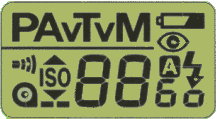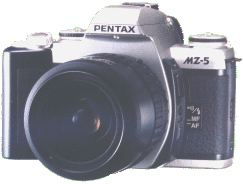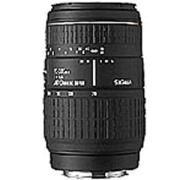
| 
| 

| 
| 
| 
| 
| 
| PHOTOGRAPHY 
I have Pentax MZ-5 35 mm SLR (ZX-5 in the USA)
and a 28-70 f/4.0 AL lens.

Pentax MZ5 35mm SLR (ZX5 in the USA)
The MZ5 was the first of Pentax's latest generation of 35mm SLRs - returning to a more traditional look and control layout, and seeming turning around the slump in market share that Pentax had experienced.
Build
Despite being very light (Pentax claim 400g without batteries) and rather small, this plastic camera is well built enough to stand rough. Metal is used where important (the lens and tripod mounts for example) and mine has
survived a few drops on the floor without damage or marking the rather attractive silver finish. The initial production runs seemed to be done in Japan.
Features
Shutter: 30s-1/2000s in auto exposure modes, 2s-1/2000s in manual. Flash sync 1/100s.
Metering: 6 segment evaluative, centre weighted and spot - all modes user selectable. With lenses prior to the A series evaluative metering is not available. +/- 3 stops exposure compensation.
Modes: Program, aperture priority, shutter priority, metered manual and bulb.
Flash: Retractable flash with guide number 11 built in - covers up to 28mm lenses. Hotshoe for use of external Pentax TTL flash units.
Auto-Focus: 3 point AF, switchable to single point. Automatically switches to predictive mode on sensing subject movement.
Motorwind: Single frame and 2 frame per second user selectable. 12 second self timer.
Other: Mid-roll switchable panoramic mode, with viewfinder masking.
Viewfinder: 0.8x magnification, covering 92% of the actual field of view. In viewfinder indications of in-focus, flash, shutter speed, aperture, exposure compensation bar graph (also used for over/under indication in metered
manual mode).
LCD screen: Film status, frame number, AE mode, shutter speed and aperture value, DX or manual film speed setting, various warnings.
Others: Electronic cable release socket, Optional AA battery pack.
Handling
Now we've got the bare facts out of the way, I'll discuss what the camera is actually like to use. First of all here is what is missing that I'd like :-
Auto-bracketing, PC socket, depth of field preview, exposure lock (MZ5n has all of these except the PC socket).
I'd gladly lose the panoramic mode and the power zoom support (the power zoom functions already aren't supported) - I know not everyone agrees with this. The camera is very traditional to use - it has an aperture ring on the lens and a conventional shutter dial. Set both to their A position and you're in program mode (unlike the Z range of cameras, program shift is not possible). Set the aperture ring to a position other than A while the shutter dial is set to A and you're in aperture priority. Reverse that with the aperture ring at A and the shutter dial at a manual setting and you're in shutter priority mode. With both off of the A position you're in manual mode. Personally I shoot 90% of the time in aperture priority, a little in program mode and often use the X-sync position in the studio. One minor inconvenience of such a control setup is that there is no space on the shutter speed dial for half stop speeds, or for shutter speeds longer that 2 seconds, even though the camera can set up to 30 seconds in automatic modes. The handling of the camera is generally good and straightforward - minor niggles are that to use spot-AF you have to keep pressing the spot-AF button
(solved on the MZ5n), and the the viewfinder information has a few important items missing and what is there can be difficult to see in strong sunlight. The main viefinder ommission that troubles me is that (unlike the Z1p) there
is no display of the current metering mode - on occasion I've switched to spot-metering and forgotten to switch back, and sometimes it can be a while before I notice. Also having a spot-meter but no AE-lock is a bit of a shame, as it really requires you to switch to manual mode to get the
benefits that a spot-meter can provide. The AF performance is pretty decent - I think the Z1p may be faster in good
light (it has a bigger motor) but the MZ5 certainly hunts less in low light. It's also a lot quieter, but still not up with the Canon EOS system with its USM lenses. Overall the camera is quiet in use in fact - I've shot in a
theatre without anyone hearing the camera, not something you'd do with the Z1p!
Compatibility
Like most of the Pentax 35mm SLRs you have access to a very wide selection of older lenses. AF lenses such as the F and FA ranges work best of course, but the A lenses retain all camera functions other than AF. The M series lenses and earlier don't have an A setting on the aperture ring, so you lose program and shutter priority modes, along with 6 segment evaluative metering. Even the earlier M42 screw mount lenses can be used with an appropriate adaptor, although you'll lose some functions.
Performance
I mostly shoot colour slide film, which is a good test of a cameras metering system. The 6 segment metering has been very very accurate, only confused by the most difficult of lighting situations - when I switch to spot-metering mode. The light weight and good handling of the camera have allowed me to take the camera when before I may have used a point and shoot, and there has been a dramatic improvement in the quality of my "casual" shooting as a result. Allied to lenses such as the FA* 24mm F2 and FA* 85mm F1.4
(conveniently a very nice cosmetic match as well) this camera has produced some of my favourite photographs.
Conclusion
A nice portable camera with traditional handling and capable of very fine results. Don't buy one though unless it's very cheap, as the MZ5n is even better. This camera is as different from the Z1p as it's possible to get within the same manufacturers range, but despite that I like them both - the Z1p for "serious" shooting, and the MZ5 for "casual" duties and when weight is an issue. I like Pentax and I want to stay with it. I am mostly
a landscape shooter but I also want to try a macro
in the future. Oh, I like zooms. Iąd like to buy a new zoom lens. My suggestion is either Sigma AF 70-300 mm f/4-5.6 APO Macro Super or Pentax 80-320 mm f/4.5-5.6 FA Zoom. ********** 
Product details for:
Sigma AF 70-300mm f/4-5.6 APO Macro Super
Sigma's 70-300mm F4-5.6 DL MACRO SUPER is one of several new tele zoom lenses. It is a compact Tele-Macro Zoom lens, capable of focusing down to 1:2 (half life-size reproduction ratio at 300mm focal length (an optional accessory 58mm achromatic close-up lens allows even closer focusing and reproduction ratios up to 1:1 or life-size), with superb optical quality. A detachable bayonet hood is provided. The lens materials used in this new product are lead and arsenic free ecological glass, including one special low dispersion (SLD) glass element. ********** RECOMMENDATIONS Nr.1:
The Pentax 100-300 does not have a great reputation. The new 80-320 seems a bit better, but a Sigma or Tamron may be better. The FA 70-210 is probably better than any of them.
Best option in that range is probably the Sigma 70-300 APO Macro, or the latest Pentax 80-320.
I'd either buy the Sigma 70-300 APO Macro or the lens Pentax have replaced the 100-300 with, the 80-320. User experience reported on the Pentax list with both of these has been pretty good, and the various reviews look encouraging.
Sigma AF APO 75-300 best - "very good" - Canon EF 100-300 USM is second best and it rates "good", Sigma AF 70-300 APO Macro is also "good". Only "satisfactory" are Sigma AF 75-300 UC APO ZEN, Sigma AF 75-300 DL ZEN. **********
RECOMMENDATIONS Nr. 2: (From my e-mail correspondence)
Hello, my wife owns the Pentax 80-320 and my impression agrees with the test summary below that I found in the English magazine Practical Photography April 2001. It works quite well but towards the 300mm end the performance is not so good. All tele zooms seem to suffer the same fault.
Sigma make two 70-300 zooms, one is the DL model and the other the more expensive APO model. It seems that the cheaper DL model actually works better than the APO model. I do own a very old version of the Sigma 75-300 APO and it was an excellent lens, one of the best, but for some reason they updated it and the new model does not work as well.
Here's the text extracted from the magazine tests.....
Pentax 80-320mm f/4.5-5.6 SMC-FA.
PERFORMANCE: Modern looking - in black or silver - with a wide zoom ring and smooth rubberised focus ring. Focus distance window includes an infrared index. Focal length is misleading at the tele end. Though not the quickest, the AF is efficient and accurate. Sharpness of the lens at the edges falls of at 135mm.
SUMMARY: Great handling and a solid AF performance, but disappointing at the long end of the zoom. Rated 6 out of 10.
Sigma AF 70-300mm f/4-5.6 DL macro super.
PERFORMANCE: Features wide zoom and manual focus rings which are contoured and smooth in use. Relatively heavy but has metal mount. Hyperfocal distance focus scale on barrel. Has excellent macro facility. Lens hood supplied. AF is reasonably quiet, and optics are impressive at this price point, but tail off at longer focal lengths.
SUMMARY: Apart from the weak results at 300mm, this is an impressive lens. Rated 8 out of 10.
Sigma AF 70-300mm f/4-5.6 APO macro super.
PERFORMANCE: Features apochromatic glass elements for reduced aberrations. Zoom and manual focus rings are wide and contoured. AF is reliable but not the quietest, and at 300mm it has a tendency to hunt in dim light. Central sharpness is very good to excellent, but edges are poor from 180mm onwards.
SUMMARY: Surprisingly, the optics aren't as good as the cheaper DL lens which offers better value. Rating 7 out of 10.
That magazine belongs to TIPA and they (about 30 European photo magazines) all use the results of the MTF tests supplied by Photodo, so you can check the MTF tests yourself at www.photodo.com and see that the Sigma DL lens is probably the better choice. Just don't use the summary
numbers, learn to read the individual MTF graphs to see how the lenses perform at different focal lengths and apertures.
When looking at all the 70-300 or 100-300 lenses on the market, it seems that none of them are of excellent quality except maybe a ridiculously expensive Canon model.
My advice is to buy the Sigma DL model now and then later if you do get serious about wildlife shots etc where you do need a good tele lens, then save up for a fixed focal length lens of say 300mm to get a better performance.
Regards........... Guy Parsons
| 
| 
|

